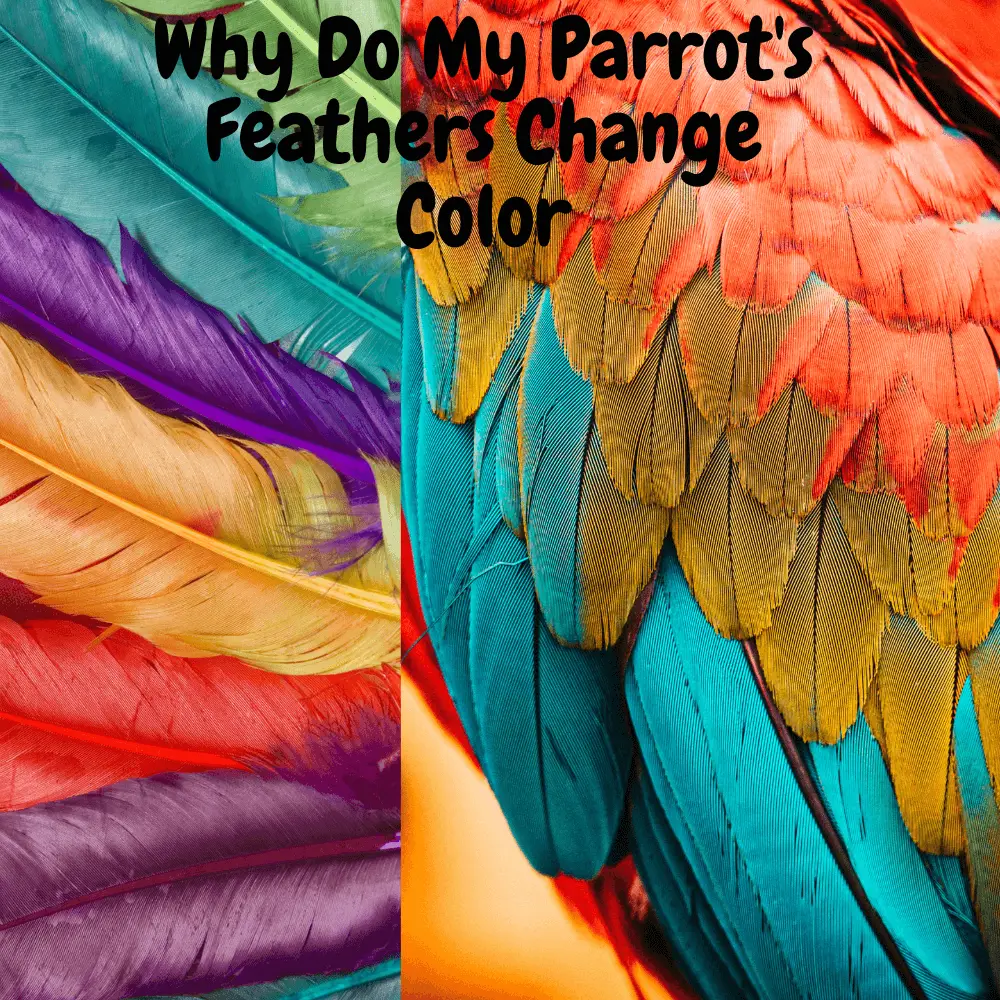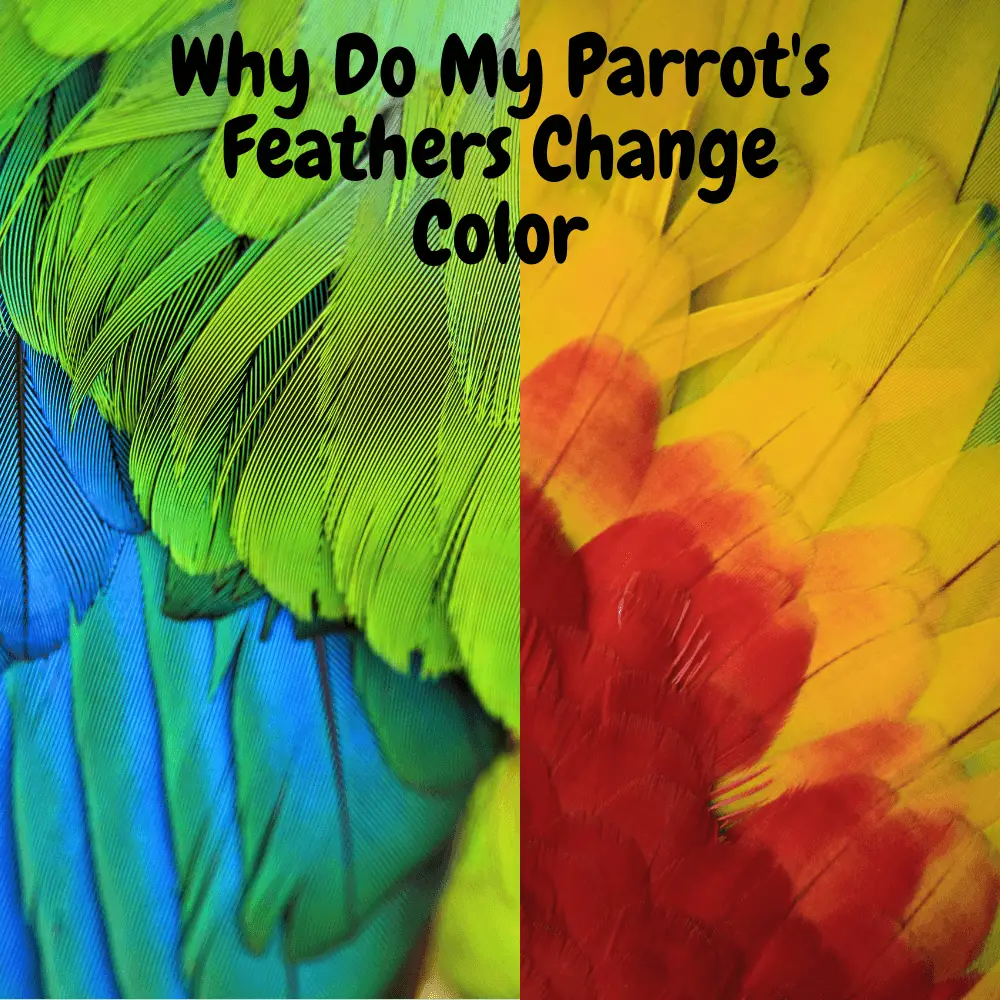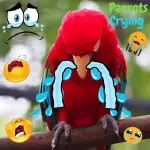
The Parrots feathers may have a duller coloration, darkening of color, colored stripes, or stripes. Each of these changes has different underlying causes.
A healthy parrot will have strong, neat, and colorful plumage, and an unhealthy parrot will have at least one symptom via its feathers. The feathers of a parrot may become gray, black, yellow, white, brown, or lose their luster. Liver disease and vitamin A deficiency are common causes of feather discoloration in parrots.
If the feathers are only slightly discolored, your parrot is preparing to molt. If undergoing medical treatment or stressed, your parrot may develop bands on its feathers. This happens most often when it loses feathers to grow new ones. Once the cause of the appearance of the bands is resolved, the feathers grow back normally.
Feather discoloration in parrots
Parrots can not choose to change the color of their feathers. They cannot, therefore, lighten or darken them, switch from one color to another, or introduce new patterns. However, feathers can change and fade depending on their state of health.
Wild parrots use the color and brightness of their feathers to choose healthy mates during mating season.
What do the feathers of a healthy parrot look like?
The feathers of a healthy parrot should have a single, unbroken stem.
The feather itself should be free of debris, and shiny, and the beards should be connected to each other. The colors should be bright and clean, and the feather should be soft to the touch.
Parrots have a wide range of colors, and most have multiple colors in their full plumage. As long as the coloring matches the rest of their body and the patterns they naturally display, they are mentally and physically healthy.
What do the feathers of an unhealthy parrot look like?
The feathers of an unhealthy parrot have a strange or dull coloration and look like a dull one. :
- Deprived
- Frayed
- Malformed
- Curved
- Broken
- Weird shapes
They can be dry or brittle to the touch. This may correspond to unusual shapes, such as:
- Scratches
- Banderolage
- Splashing

Why have my parrot’s feathers changed color?
There are several reasons why a parrot’s feathers can change color, including:
Maturity
The feathers of a young parrot change color as it grows and molts its juvenile down feathers.
The down feathers of most parrots are a mixture of whites and grays. When these soft, fluffy feathers are lost, they are replaced by those of an adult parrot.
These new feathers should be shiny, strong, and elegant. Their colors will match the normal tones of their species, with some normal variations.
A parrot’s feathers do not change naturally after the down is shed, except for the following reasons:
Health
Nutritional disease or deficiencies can cause markers to appear on growing feathers, such as:
- Stripes or stripes
- Discoloration spots
- Discolored sections
Various health problems can cause a parrot’s feather to change color, including:
Nutritional deficiencies can interfere with how the body produces pigments and feathers. This may be due to a lack of vitamin A, sunlight, and protein. Similarly, excess fat can cause the darkening of the feathers.
Feather follicles
Feather follicles are delicate structures, and any damage or irritation can interfere with their regrowth.
The feather can be deformed, which limits its ability to reflect light. When nanostructures are malformed, colors like blue become paler. Thus, even a slight deformation can lead to a lack of color.
Although many things can damage the follicles, the most common reason is the pulling out of feathers. Feathers fall off naturally and are repelled when they are too old, and feathers pulled off too early or abruptly can cause irreversible damage.
Trauma can cause inflammation or infection of the follicles. If your parrot has been fighting, this stain may not recover.
Molting
The molting process makes it possible to lose old feathers and replace new ones.
When a feather reaches the end of its life, it may take on a frayed appearance with a duller coloration. On the other hand, newly growing feathers will be brighter and more colorful.
Depending on their species, parrots molt 1-3 times a year. Monitoring your parrot during a molt is a good way to check a parrot’s health.
How do parrot feathers change color?
Parrots do not naturally change color, but they take on their colors as they age. This is because all feathers contain pigments, which is called chemical dyeing.
These pigments react to hormones and chemicals in the parrot’s body as it matures. Pigments can change hue or turn into entirely new colors.
Parrot feathers contain pigments called psittacofulvins. These are bright red, orange, and yellow pigments found only in parrots.
Other families of pigments include:
- Melanins
- Porphyrins
- Carotenoids
Carotenoid pigments are the same colors as psittacofluvins. These come from the ingestion of plant matter. However, even though carotenoid sources make up the bulk of the parrots’ diet, the plumage of this species is not affected by food.
The coloration of parrot feathers is affected by the reflection of light, which is called structural coloring. Most parrots have a combination of structural and chemical coloration. For example, blue feathers are not created by a pigment. Rather, they form because of the reflection of light into the nanostructures inside each feather.
Since most tones are affected by a parrot’s chemical balance, the disease can impact its feathers. In case of malnutrition and stress, the structure of the feathers will be damaged, and you will notice fraying and bands.
Parrot feathers take on a different color
There are a small number of reasons why the feathers of a parrot can change color. While not a hard and fast rule for all species, the new coloring can allow you to assess the reason for this change.
Going black
Have your parrot’s feathers darkened significantly or have they turned black?
If so, it is a warning sign that the parrot has excess fat or protein in the body. A vitamin A deficiency can also cause black feather tips and edges, but the same goes for thinned feathers.
Turning yellow
Cockatiels with liver disease may develop bright yellow feathers rather than black feathers. Diseases, such as fatty liver, can be fatal if left unresolved.
Turning brown
Parrots need to bathe several times a week. Dirt and grime can give feathers a slightly brown appearance.
Check your parrot’s favorite perches. Are they covered in feces and dirt? If so, clean them up as the debris is probably rubbing off on the feathers.
Becoming gray or dull
The feathers of a parrot begin to tarnish as it prepares to molt.
The feathers then turn gray or ashy. An excess of parrot dust can tarnish or gray the natural liveliness of the plumage, giving the feathers a white appearance.
Shredded or frayed
A disease requiring drug treatment could cause feathers to regrow with different markers or colors.
For example, African grays sometimes have scattered red feathers in their plumage due to damaged follicles or medication. These feathers return to normal after molting.
Patches of different colored feathers that are shredded or damaged may indicate injury or infection of the skin or feather follicle.
Parasites can cause irritation. A parrot may overfeed or bite the area, which will further irritate the skin and feathers.
How to improve the quality of parrot feathers?
To allow your parrot to maintain healthy feathers, offer proper care in all aspects of his life. This includes their meals, their environment, and their access to sunlight.
Avoid stress
Long periods of stress are responsible for the formation of feather strips, which leads to behavioral problems and the pulling out of feathers. A stressed parrot is therefore probably unhappy, bored, or lonely.
Place the parrot’s cage in a room without activity and noise. Your parrot will find this unsettling.
Make sure the cage is large enough, with toys and enrichment items. If you make changes, do it gradually.
A socialized parrot is a happy, stress-free parrot. Spend time with your parrot and allow him to join you in other parts of the house, such as offering him a perch in the living room.
Keep the cage away from any air vents, fans, or air conditioning units. These airflows can be stressful and are known to dry out parrots’ feathers and skin.
Diet
Although parrots do not depend on food for their pigmentation, diet plays a crucial role in maintaining healthy feathers. To promote feather health, provide foods rich in vitamin A.
Foods rich in vitamin A include:
Exercise
The prevention of obesity and related diseases requires a balanced diet and exercise. A happy parrot needs mental and physical exercise through socialization, play, and puzzle toys.
An enriched parrot will be more active and will not feel the need to pull out its feathers because of stress or boredom.
Sunlight
Sunlight is essential for maintaining strong, alive, and healthy feathers.
Place part of your parrot’s cage in an area with direct sunlight. UVB lamps are an alternative to sunlight. Remember that after 6 months of use, the light will stop producing UVB rays.
Related Articles:
- Parrots feathers
- Beak and feather disease
- Feather plucking
- The size of the flight feathers of parrots
Share this article with your parrot friends on social networks!




















